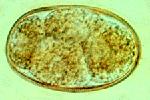Difference between revisions of "Ancylostomatoidea"
Jump to navigation
Jump to search
m |
|||
| Line 12: | Line 12: | ||
== General Appearance == | == General Appearance == | ||
| + | [[Image:Ancylostoma.jpg|thumb|right|150px|''Ancylostoma'' - Courtesy of the Laboratory of Parasitology, University of Pennsylvania School of Veterinary Medicine]] | ||
*Like the Strongyloidea, except the head is bent dorsally. | *Like the Strongyloidea, except the head is bent dorsally. | ||
*All have a large buccal cavity with teeth and/or cutting plates. | *All have a large buccal cavity with teeth and/or cutting plates. | ||
Revision as of 13:58, 23 December 2008
| This article is still under construction. |
|
|
General Appearance
- Like the Strongyloidea, except the head is bent dorsally.
- All have a large buccal cavity with teeth and/or cutting plates.
- Some also have teeth and/or cutting plates around the mouth.
General Life-Cycle
Like that of the Strongyloidea, but infection can be by ingestion and/or skin penetration.
- Ancylostoma in myositis
- Ancylostoma and Uncinaria in skin infections
